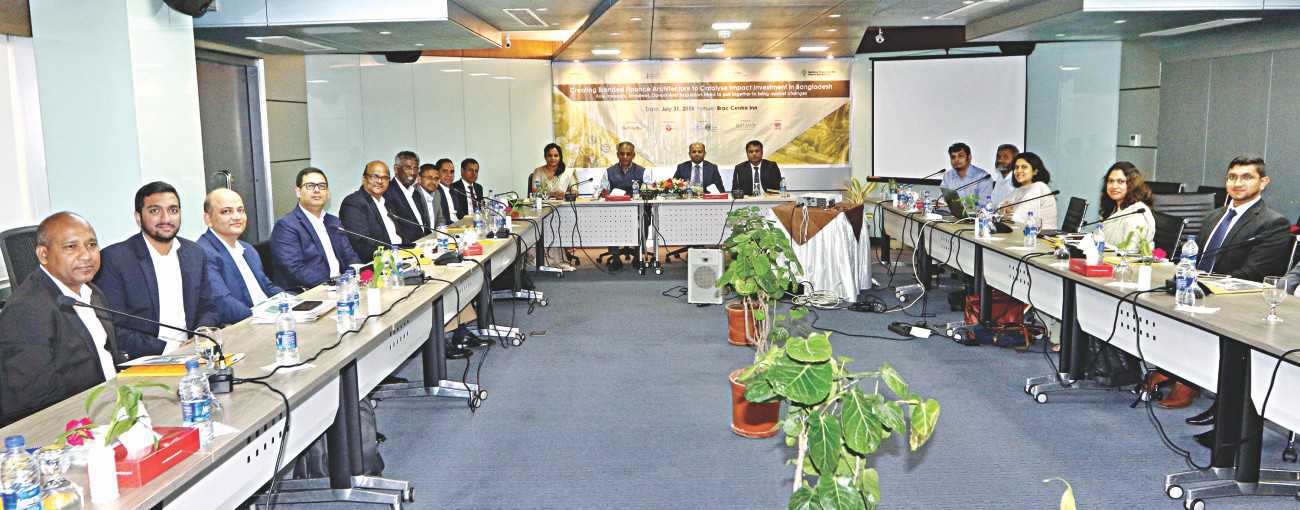Creating blended finance architecture for catalysing impact investment in Bangladesh

Image collected
Over the last four years, BFP-B has made three investments in Alternative Investment Vehicles (AIV). We did this to find an alternative instrument, particularly in terms of equity for small businesses. There has been a lot of discussion around this issue including commitment from the government.
Around 17 fund manager licenses have been issued, out of which only two actually applied for a license. The government is providing licenses to fund managers but the registration has not happened because the fund has not been organised yet. It is a challenging situation. So, we will try to figure out what the major paying points are in terms of regulation, investment, pipeline and deal flow and so on. Hopefully, we will be able to generate some effective recommendations for both the government and investors from today’s discussion.
First, a big structure and cost are required for discovery and origination.
Second, there is not sufficient investment in capital, which can then be re-invested.
Third, costs of regulations. If small companies have to go through the same processes as others, their costs would get pushed upwards.
Fourth, general regulations. Although the regulation environment was there for licenses to come along, issues about repatriation, taxation and dividends still remain.
Fifth, there aren’t enough players in the market. People are not aware of these sorts of investments.
Hasan Imam, Chairman, Bangladesh SME Corporation Ltd.
SMEs are large in number. Most of them are financially disorganised with no income statements, balance sheets or cash flows that banks need in order to check their creditworthiness. It discourages banks from targeting the SME segment.
However, in terms of creditworthiness, SMEs are not lagging far too behind compared to corporates. In fact, micro-finance organisations in Bangladesh have far less non-performing loans (NPLs) than banks. Yet, SMEs still face many challenges in getting financing.
Usually, angel investors provide few lakhs to help start a business. But during the scale-up period, micro-entrepreneurs do not get the required funds. The effective interest rates of Microfinance Institutions (MFIs) are very high, around 25-29 percent. Beyond MFIs, funds should come from formal institutions such as banks and impact funds to decrease the cost of funding.
The entire non-urban market is absent from the capital market because there is no institutional presence there. A big ecosystem needs to be developed to create access for the institutional investors to reach these untapped areas.
Azad Chowdhury, Secretary General & President, Impact Initiatives, the STEPs
The problems faced by non-urban MSMEs are complex, and skillsets required to derive solutions do not reside within a single entity or type of organisation. We need a multitude of skillsets to come together for a successful intervention. At STEPs, we have built a unique platform that brings together the collective strengths and insights - to apply technology as an enabler; to democratise financial products that are fit-for-purpose; and to provide the monitoring capabilities for the last mile. The impact arena is new to Bangladeshi investors, particularly for banks. The overall global impact investment capital is an area where Bangladesh has not tapped into efficiently. At STEPs, we have established the entire infrastructure necessary to do such an intervention, which will enable local and international investors to access a variety of creditworthy MSME investees.
Present regulations do not allow the open-ended fund structure that international investors need for impact funding. The limited three-year capital raising period for alternative investment funds (AIFs) works against our agenda – having an open-ended structure creates a continuous process of liquidity injection and repatriation of dividends which is required for a sustainable investment lifecycle mandated by all institutional investors. Moreover, AIFs are allowed to invest via equity only, no debt - which is not in line with the real needs of the market and not in line with global impact investors.
It has been reported that Bangladesh is behind by USD 1 trillion in reaching SDGs. A lot of international investors are SDG-focused impact investors. So, we have developed a way to track investments in a way that measures specific contribution to the SDGs (at both a singular and portfolio level).
Almost all international investors want to see active Bangladeshi investors in a fund before they make an investment. Lots of banks exist in Bangladesh, but not a single one backs an impact investment fund - we need to give incentives to these actors to join our efforts.
There are challenges in bringing money into Bangladesh, as international investors continually question the repatriation process. The track record of our country in this regard has not been encouraging.
The size of investment we need for our first fund is around USD 50 million. To be able to deploy USD 50 million, we have already a footprint that can deploy, monitor and recover investment returns. The brick-and-mortar infrastructures that BSCL has built can cater to this for now, but to do it at a national scale (i.e. USD 1+ billion), we need to be able to reach millions of people with SME ideas.
Source: https://www.thedailystar.net
Previous Story
- SMEs’ listing on DSE this year very unlikely
- Indian Railways battles to extend lines in Northeast
- SME owners should have private number: Route Mobile...
- Bangladesh- City Bank launches exclusive women banking service...
- Bangladesh- Amex, SIA partner to launch first SME...
- BIDA to create 24,000 new entrepreneurs in 2yrs:...
- Credit lines stressed for maximizing export competitiveness
- Bangladesh- SJIBL opens 125th branch at Arani Bazar...